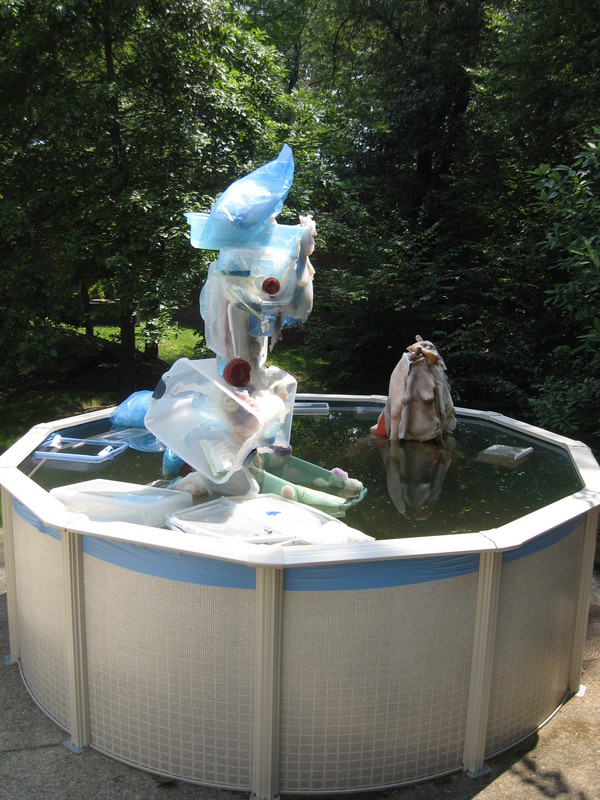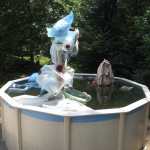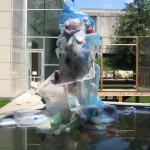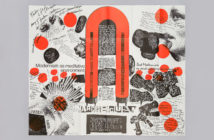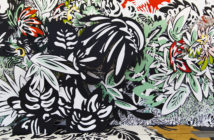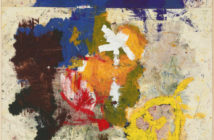To the left of the Rose Art Museum's front entrance, down a short path, an abject oasis awaits, appearing from a distance like an abandoned backyard pool party. An above ground pool, the wooden deck, a potted palm tree, party lights, some gnarly abstract sculpture. When I visited in August, it was hot as hell, and from far away this partially shaded scene looked like heaven.
Not so, one quickly observes. The pool is polluted with dozens of plastic storage bins floating amid other variety of trash, dead leaves, with two rather large totems rising above the surface. One is a tower assembled out of plastic household items, the other, a hideous pile of fleshy malformed rubber body parts, torn up into bits of deflated breasts, faces, penises, hands, feet, bellies, etc, not unlike swamp thing. They are terrible to look at. The swamp thing is especially confrontational. In such putrid heat, the brown still water reeks. Several insects have met their end in the treacherous waters and seeing them float around decomposing adds a particularly unkind foulness.
On the viewing platform overlooking this scene, which here acts like any poolside deck, sits a modern black leather couch, partially decorated with a hodge-podge of ceramic kitchen and bathroom tile, covered in resin which bakes in the sun like sap hardening into amber. The couch is in bad shape even without the unwelcoming mess of tile and resin, its seams ripped open to reveal its inner coil and stuffing.
Next to the platform lay another totemic effort that has since doubled over onto the ground: white plastic lawn chairs caught up in a five or six foot tall armature of wood and concrete, collapsed. According to the press release, the installation is intended to deteriorate over time and remain installed until fully disintegrated. As the clearest reference to previous examples of postmodern sculpture, this component of Aboutthing (in the air) is actually quite compelling as formal sculpture in its own right. Commonplace materials coalesce into a dynamic up-do, flush with memory and narrative folly.
In a statement accompanying Aboutthing (in the air), artists Ryan Trecartin and Lizzie Fitch point to the Great Pacific Garbage Patch or Plastic Island for inspiration, an area of the North Pacific in which plastic and other debris are trapped by the currents of the North Pacific Gyre. Obvious material/conceptual connections are made. A glut of consumer excess leads to pollution so grand, a tropical island is formed out of the throwaway somewhere between LA and Japan. A symbol of success, consumer happiness, comfort, privacy and luxury, asking endless maintenance, a wretched pool is a palpably felt insult to the senses as well as to civility. Gazing into Trecartin and Fitch's pool we feel horror similar to gazing at a ruined lake, a polluted shoreline or a contaminated river.
Making the metaphor even more painfully contemporaneous is the shaky ground on which the Rose Museum now finds itself. Earlier this year, to resounding national publicity and criticism, Brandeis University announced that the museum would close and sell its outstanding modern art collection citing a loss in the university endowment. Since then a steady flow of backpedaling and vagueness, student-led protests, a lawsuit, and still no idea of what the future holds for the Rose. Like an unfortunate suburban home under risk of foreclosure, the Rose awaits its verdict, complete with its neglected and erstwhile swimming pool.
The metaphor only extends so far. Brandeis has rescinded its decision to close the institution. However, certain high-valued objects from the collection may still be sold off to raise funds. Regardless and perhaps in spite of that, Trecartin and Fitch deliver a smug, mischievously dark and many-layered nightmare party in response to the crumbling economic/environmental misfortunes of our day. They revel in the chaos, like viral internet superstars come alive.
Such is their hallmark, what has garnered them attention at galleries and museums worldwide as well as on YouTube, and would explain the praises they've won recently after their warped, hyper-performative video installation was included in the New Museum's recent inaugural triennial for new art the Generational: Younger Than Jesus (New York).
What trouble we've stumbled into. The bathing pool in western art has usually been a sign of good times, a place where beauty is reflected and where sensuality is enjoyed. Just think of how different Aboutthing looks compared to David Hockney's pools. The Rose, feeling the brunt of hard times, deserves high marks for bringing such challenging, experimental, difficult art to greater Boston, continuing to do with dignity what they've done seriously since its inception only 48 years ago.
Rose Art Museum, Brandeis University
"The Aboutthing (in the air)" is on view at the Rose Art Museum, located on the Brandeis University campus, in Waltham, MA.
All images are courtesy of the courtesy the author, the artists, and Elizabeth Dee Gallery, New York.

